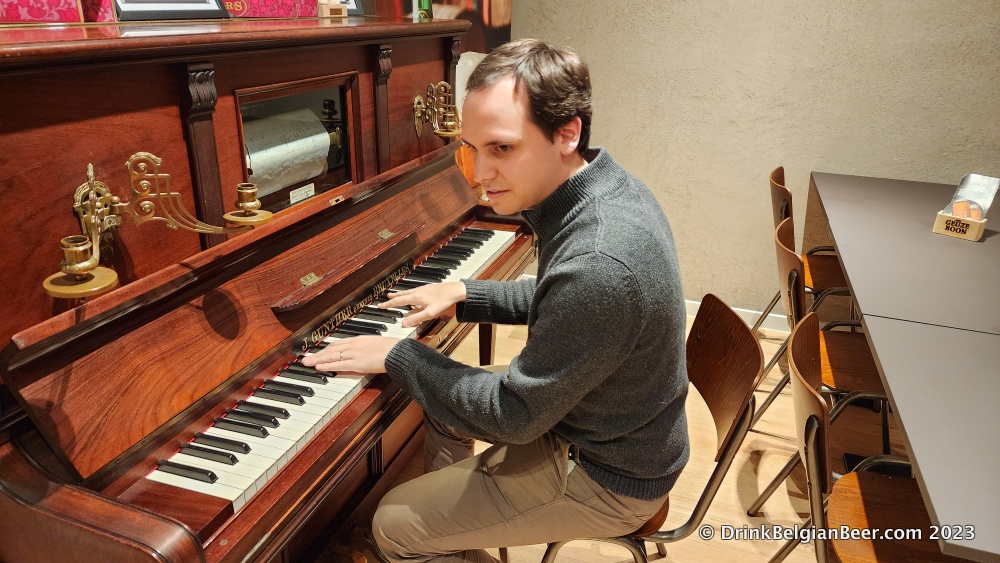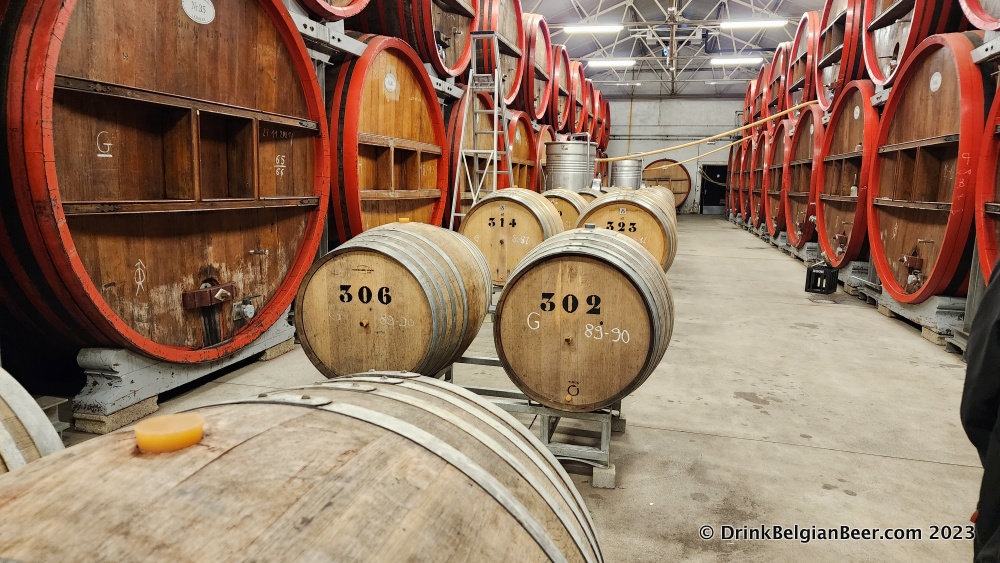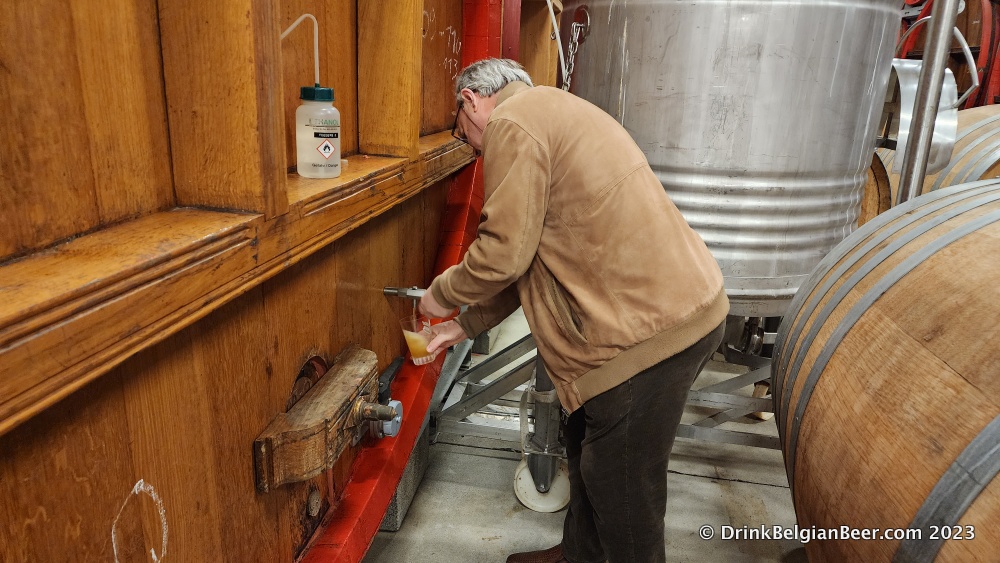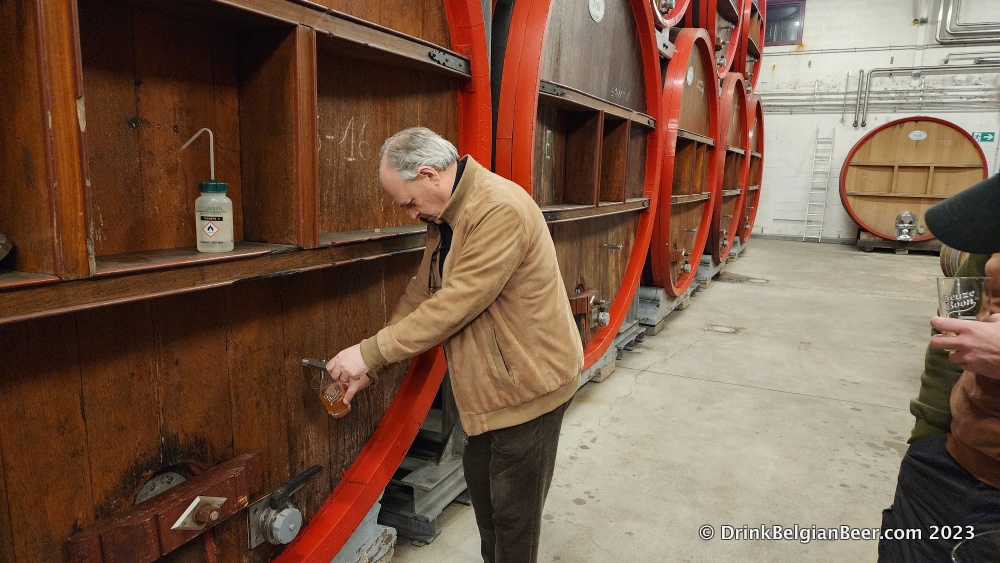A visit to the hallowed Brouwerij Boon-which has the largest stock of lambic in oak barrels in the world, at 2.1 million liters-is always a great pleasure. The brewery, located in Lembeek, about 18 km/12 miles southwest of Brussels, in the Province of Flemish Brabant, added a new, multi story tasting cafe, called Boon Bar, and a retail shop at the end of 2021.

Incidentally, 2.1 million liters-or 21,000 hectoliters-works out to nearly 18,000 U.S. barrels. That is a huge stock of lambic! Boon’s beers, such as their world classics, which include Boon Oude Geuze, Boon Oude Geuze Mariage Parfait, and Boon Oude Kriek Mariage Parfait, are considered as some of the best lambics in the world. The low, mellow acidity, complexity, mild funk, and drinkability of these brews are what draws them to many a lambic lover around the globe.




The history of Brouwerij Boon could be the subject of a book, and much of it is covered on the brewery website here.
Frank Boon was interested in Belgian specialty beers by 1972, and traveled around Belgium, tasting interesting brews. Frank, who is from Halle, a historic town ten miles southwest of Brussels, was really drawn to the lambic and geuze beers of his own region. Since 1970, Frank knew René De Vits, a highly respected lambic blender known for making soft, mellow, fine lambic and geuze. Despite the reservations of his family that producing lambic might not be a successful endeavor, Frank started a small blendery in Halle, with the objective to buy the De Vits lambic blendery a few years later. Due to his interest in specialty beers, Frank combined the small blendery with a beer distribution business, specialized in craft beer. It was the first of its kind in Belgium.


Frank bought the De Vits blendery in 1978, in Hondzocht, and began blending lambic there. In 1982, thinking to the future, he purchased a huge old bankrupt factory at Fonteinstraat 65, near the center of Lembeek.

In 1986, Frank moved his lambic blendery into this site, which, with its high ceilings and large open spaces, was perfect for installing large foeders for the purpose of fermenting and maturing lambic.

The next step is the dream of many lambic blenders: to become a lambic brewer. By the autumn of 1990, a brew house had been assembled from second hand equipment, and was installed inside the large building. “New brewing equipment was far too expensive to afford in those early days,” Frank explained.
The first brew was made that autumn, using a cast iron mash tun dating to 1896. I witnessed this historic relic in action during my tour in November 2008. In 2011, a new stainless brewhouse, specially built to make lambic, was installed, and the first brews on this system happened in 2013.
Brouwerij Boon has won many awards for their lambics at various beer events over the years. Boon is the only brewery in the world to have always won a gold medal, in the same category, during a period of more than ten years at the World Beer Cup.
Brouwerij Boon has helped many lambic blenders by selling them wort to use in their own barrels. All of the wort used by Oud Beersel in their delicious lambics and lambic blends is sourced from Boon, using the original Oud Beersel recipe. Gueuzerie Tilquin uses Boon wort, along with wort from several other breweries, in many of their excellent lambics. Wort from Boon is also currently used by Hanssens and De Oude Geuzestekerij De Cam, and was previously used by Brouwerij 3 Fonteinen, up until 2018. Smaller producers, such as h. Ertie (Uli Kremer) also use Boon lambic in many of their blends.
Frank Boon was also one of the co-founding members of HORAL, The High Council for Artisanal Lambic Beers. HORAL was founded in 1997, and is a non-profit organization comprised of most of the lambic producers in the Payottenland and the Zenne River Valley. Frank was the Chairman of HORAL for four years, from 2015-2019. This from HORAL: “The main objective of the association is the promotion of traditional lambic beers, in particular Oude Geuze and Oude Kriek. The association also takes initiatives to protect these beers. Every two years HORAL organizes the Toer de Geuze, the open brewery day of the Pajottenland and the Senne valley.”
Frank Boon’s huge positive impact to the world of lambic brewing cannot be overstated.

Frank Boon is now regarded by many as the “Saviour of Lambic” for his efforts to help keep the style from going extinct in the 1970’s and 1980’s, when traditional lambic was at the very lowest point of its popularity. As we know now, he was very successful. The Lambic style is very popular, with dedicated fans all over the world. That’s probably why you, dear reader, you are perusing this article, correct? If so, you came to the right place!
Frank Boon is undoubtedly one of the most knowledgeable lambic experts on the planet, as he has demonstrated many times over the years at events such as the The Great Lambic Summit in Philadelphia in 2010, and the Lambic Round Table at Brouwerij Boon in 2022. Frank was also the Grand Master of the prestigious Knighthood of the Brewers Paddle for a number of years.


Frank Boon retired on January 1, 2021, leaving Brouwerij Boon in the capable hands of his two sons, Jos and Karel Boon. Frank still lives a stone’s throw from the brewery and legacy he founded, and in fact, can often be seen there. In honor of his retirement, a special beer, Oude Geuze Apogee, was produced: “Oude Geuze Apogee is a celebration of Frank Boon’s extraordinary achievements. At the same time, this one-off edition celebrates the handover to Jos and Karel Boon. That transition from one generation to another is reflected in the composition of this geuze. Because for Apogee, Frank created a special blend with lambic beers from the oldest (Number 79) and from the newest (Number 83) foeders. The Oude Geuze Apogee was bottled on 29 April 2019.”


I was already very familiar with Brouwerij Boon, having visited many times over the years, including a personal tour from Frank in 2008. Brouwerij Boon is also one of the most festive spots to spend a few hours at during Toer de Geuze, the lambic festival that is a sort of open house at most of Belgium’s lambic producers. There were over twenty five lambics on offer at Boon during the 2022 version of Toer de Geuze on April 30 and May 1, 2022. Incidentally, the next version of Toer de Geuze will be held on May 4 and 5, 2024.




I also attended the Lambic Round Table that was held at Boon on the night before the last Toer de Geuze, April 29, 2022. It was a very atmospheric spot for an important lambic event.


I visited Brouwerij Boon again in February 2023, with the intention of talking lambics with Frank, while checking out the new tasting cafe for the first time, with a few lambic-loving friends. This was my first visit to Belgium during lambic brewing season-the cold weather months-since before the pandemic, in December 2019. For anyone that has not visited Belgium or its lambic breweries and blenderies in the winter, I heartily suggest it. There are far less people traveling than in spring, summer, and autumn, it is easier to find hotel rooms, as well as seats in great restaurants and cafes, and most importantly, you can talk to the brewers, and watch their coolships fill with hot steaming wort.

Brouwerij Boon is an easy three or four minute walk from the Lembeek train station, which is on a direct line from Brussels. So it is very easy to make the short trip (20 minutes from Brussels) and spend a few hours sampling beers in Boon Bar, which also offers small snacks such as bread and sausage, cheese made with Oude Geuze Boon Mariage Parfait, and a pot of pate made with Boon Oude Geuze.


After meeting friends, including Ulrich “Uli” Kremer of the h. Ertie lambic blendery, we tasted some eighteen-month old Boon lambic from ceramic pitchers in the new cafe. Frank then suggested we could take a little tour of the brewery, to which we said yes, of course! Our first stop was the circa 2013 brewhouse, which replaced an earlier and smaller one.

Frank remarked that, during the lambic brewing season, Boon will brew 16 times per week, with a batch size of 125 hectoliters (about 106.5 U.S. barrels.) This is about 2,000 hectoliters (hl) per week. Frank added that the brewery has five barrel rooms, the largest of which is actually outside, on the right bank of the Zenne (Senne) river. The brewery, which was an old foundry when Frank purchased the site in 1986, is on the left bank of the Zenne.
The largest foeders on the right bank of the Zenne have a capacity of 270 hl (230 U.S. barrels) while most have a 250 hl capacity. The foeders within the brewery have a capacity of between 40 hl and 125 hl. Brouwerij Boon now has an incredible 161 oak foeders. Boon also has a number of smaller of casks of about 400 to 600 liters.
Frank remarked: “We believe in keeping our foeder rooms and brewery clean,” to which Karel added “80% of the job is cleaning.”
After a very interesting discussion in the brewhouse (see the video above) we walked outside and headed up several flights of stairs to the top floor, where the “Gijlkuip” (gyle in English) barrels are located. Frank had this to say: “This vessel is used to hold Lambic wort for a couple, up to a maximum of 12 hours. In the coolship, lambic wort is cooled down, it takes in a good portion of wild yeasts, and is allowed to stand to deposit a large volume of solids, eg. small hop particles, protein matter, phosphates, etc. The smaller particles, however, are then still in suspension. When the wort is transferred to the gyle, these particles are separated by natural flotation and sedimentation. This is important for the quality of Lambic wort and the final beer.”
We then headed into the largest barrel room inside the brewery, and Frank and Karel discussed lambic brewing a bit more. Karel talked about opening a bottle of De Vits Geuze (the predecessor of Boon) from 1973, which tasted similar to the Boon Oude Geuze of today. Frank spoke about working with mellow, delicate lambics to make a refined geuze. Delicate, in this case, meaning with a low acidity. “René de Vits and others taught me that you must have delicate lambics to make a fine geuze,” Frank says.
Karel Boon handles Marketing and IT for Brouwerij Boon, and has done so since 2017. Karel attended KU Leuven University and studied Applied Economic Sciences, and also completed a six month brewing internship at Brasserie de Chimay. Yes, Chimay Trappist. Karel is also a classicly trained pianist.

He says: “I’ve been playing since I was nine years old. Outside of regular school hours, I’ve been to a music academy for nine years, and ended that study with a score of 92% for piano. My main focus has always been classical music of the romantic era (the end of 18th century to the first half of the 20th century). It’s just fantastic to play a piece from that era where you have nice and calm music which needs to be played very elegantly, but that often has musical moments where the tempo rises, and a climax builds up to great musical harmony, where it seems you would need an extra hand to actually play the piece. But when you pull off playing that, it’s just a great feeling, and the music just sounds fantastic!”
Karel added: “Think of Chopin, Liszt, and Rachmaninoff for instance, or even later pieces of Beethoven. I used to play piano for many hours every day. Today. I try to play on a weekly basis, at least.”
So, back to the tour and tasting. Frank also discussed how acetic acid is just an infection, and should be avoided. “We don’t have it in our foeders, only in some of our smaller barrels. The lambic from these few barrels would only be used to blend to make a faro, as that lambic is not suitable to make a fine geuze.”


“It is fruit flies that carry the acetic acid on their feet, and carry the infection into barrels if they are able to get into a barrel,” Frank continued.
Then, it was time for a bit of tasting. My favorite part of any brewery tour! Frank first poured us a sample of one week old lambic, which was very cloudy, yet still tasty, with a pleasant, mild bitterness. Other than tasting hot wort that was brewed the same day at other lambic breweries, this was the youngest barrel-aged lambic I had ever tasted. Also, though it looked like a hazy IPA, thankfully, it was not.

We then moved on to an eight month old lambic, pulled from Foeder/Vat number 40. It was young, but very good, and showing very positive signs of potential for aging.

Frank then headed over to Foeder 61, and remarked that we are now going from tasting an eight month old lambic (from Foeder 40) to a nearly three and half year old one, and that there would be quite a difference in taste. He was correct: the lambic was fantastic: complex, refreshing, with a low, mellow acidity, and pleasant funkiness. I think it would make for a great addition to the Boon Oude Geuze Mono Blend series. Hopefully, we will see a Vat 61 in the future!

We then moved on to another foeder-one of the best Boon has for aging lambic, per Frank-Vat number 31. This Foeder has a long history, and here it is: “The lambic in Foeder 31 that was used for this Oude Geuze Boon VAT issue matured for four and a half years. Foeder 31 is a large oak barrel that was built between 1905 and 1908 by the Bodenheim company in Kassel (Germany). The barrel ended up in a Brussels lambic brewery in 1919 as part of a large batch of material that was sent to Belgium as compensation for the damage suffered by Belgium during the First World War. The cask served in this brewery until 1988, when it was sold together with 20 other foeders to the Boon brewery.

Initially, these casks were used to ripen 1-year lambic for Oude Geuze Boon. The casks that produced the finest lambic, including Foeder 31, were reserved from 1992 for the production of Geuze Mariage Parfait. In 2008 the barrel was due for a major overhaul. Cracks were found on the underside. The cask was partly dismantled in the coopers workshop. Twelve staves (the wooden beams that make up the barrel) were replaced by new ones.


On November 30, 2015, Foeder 31 was filled with lambic from Boon’s new brewing hall for the first time. The extra aromas added by the new oak and the now 100-year-old microflora in the wall of the barrel gave a particularly fine lambic after 3 years of maturation. Frank Boon therefore decided to allow this lambic to mature further. Frank and his sons only bottled the lambic after 4 and a half years in the barrel. Never before have they allowed lambic for VAT production in the cask to age more than 3 years. The results are impressive. VAT 31, brewed on November 30, 2015 and bottled on May 14, 2020, has become a delicate, fine Oude Geuze with a fine sparkle and a pleasant cognac-like nose. The velvety yet firm aroma with notes of apricot and nuts is underpinned by a clear oak character.”
Frank Boon remarked that the Vat 31 Oude Geuze Mono Blend was, in his opinion, one of the finest Oude Geuzes ever made. The vat was refilled with wort brewed on May 20, 2020, so it contains lambic that is now nearly three years old. Like the lambic in Foeder 61, it was superb: complex, refreshing, with a low, mellow acidity, and pleasant funkiness.
Will be see a Vat 31 Mono Blend, Version 2? Only time will tell.
Frank also let us taste a couple of much more acidic beers that they have in smaller casks, that had acetic acid in them, just to demonstrate the difference between delicate, mellow, fine lambics, and ones that are overly acidic.

After the superb tour, we then headed back to Boon Bar to sample a few more lambics. We decided to start with an Oude Schaarbeekse Kriek Boon, Vintage 2019. This beer is described as such: “Oude Schaarbeekse Kriek Boon is made with 250 grams of Schaarbeek cherries per litre. These cherries are harvested in Belgium and have a strong flavour. They combine the gentle and slightly tart flavours of the Lambic beer with a very intense but balanced cherry expression to create a smooth, rounded finish. An additional six months of ageing in oak barrels adds further complexity. The result is a particularly rich taste experience.”

After savoring the excellent, fruity, and well-balanced Schaarbeekse Kriek, and then another excellent Oude Geuze, it was sadly time to head out. What a day it was, though!

Brouwerij Boon is a destination spot that any and every lambic fan should visit. If you are lucky, you might even see Frank there! Boon Bar is open to the public from 1 to 7 pm on Fridays and Saturdays (and closed on public holidays.) The Biershop (for retail, aka take away) is open from 10 am to 6 pm on the same days as the bar. Individual visits of the brewery are possible on Saturdays. For info on group and individual tours, see their website here. I highly recommend a visit!
The brewery is located at Fonteinstraat 65 in Lembeek. The telephone number is +32 (0)2 356 66 44
The beers of Brouwerij Boon are imported into the U.S. by Global Beer Network. For additional info, see here.
While Brouwerij Boon and the on-site Boon Bar and Biershop are easily reached via public transport, the same cannot be said for many of the other cafes, restaurants, breweries, and blenderies in Belgium’s Payottenland and Zenne Valley. Lambic country.
As far as how to get around Belgium’s lambic country, to places hard to reach by public transport, a professional lambic guide or tour group is often the best way to go.
If you would like to do day trips around lambic country, where you organize your own accommodation and meet your guide/driver, one such lambic guide is Patrick Van der Spiegel. As a resident of Halle, ten miles southwest of Brussels in Belgium’s lambic country, he has lived his life savoring and enjoying lambic brews. Patrick has two projects, “The Land of Geuze” and “Lambic Tours” which both have Facebook and Instagram pages. The Lambic Tours website is here.

To sum up, Patrick Van der Spiegel organizes tours to lambic breweries, geuze blenderies, and traditional Belgian pubs in and near the Pajottenland and the Zenne Valley. Patrick guides these tours himself, and can do so in English, Dutch, and French. In addition, there is the possibility to pair these tours with guided tours at breweries or blenderies, with professional tour guides, or lambic brewers/blenders. These tours typically include tasting samples of multiple beers, and an optional lunch or dinner for the whole group.
If you are interested in these custom guided tours, feel free to fill in the contact form on their website (lambictours.com) or send an email to patrick@lambictours.be. It is also possible to send private messages through their Instagram and Facebook pages.
Patrick’s lambic tours can be summed up in one word: Marvelous!

Leave a Reply